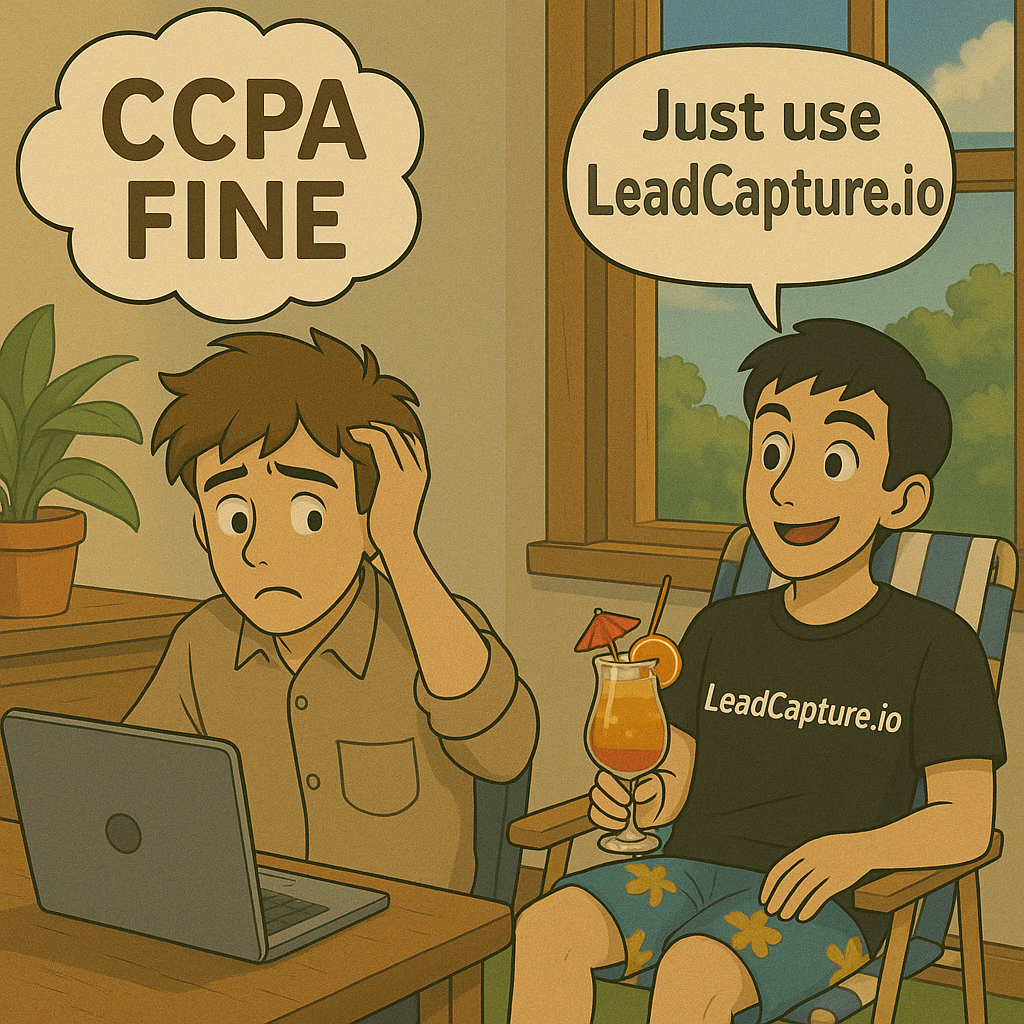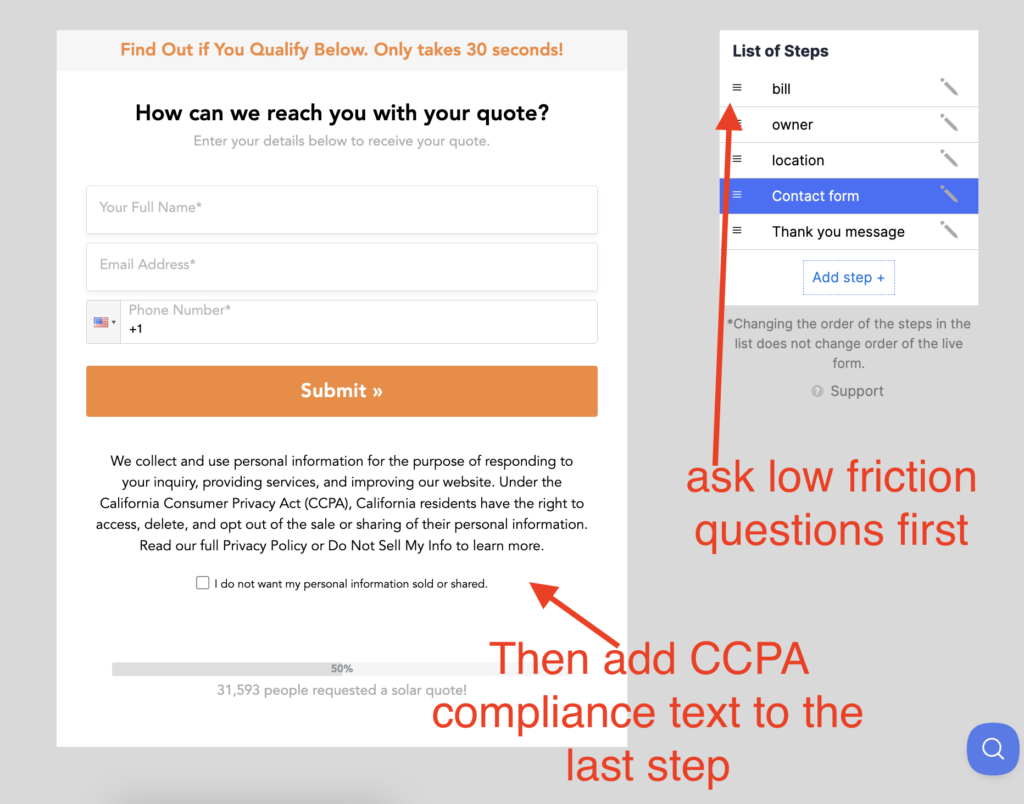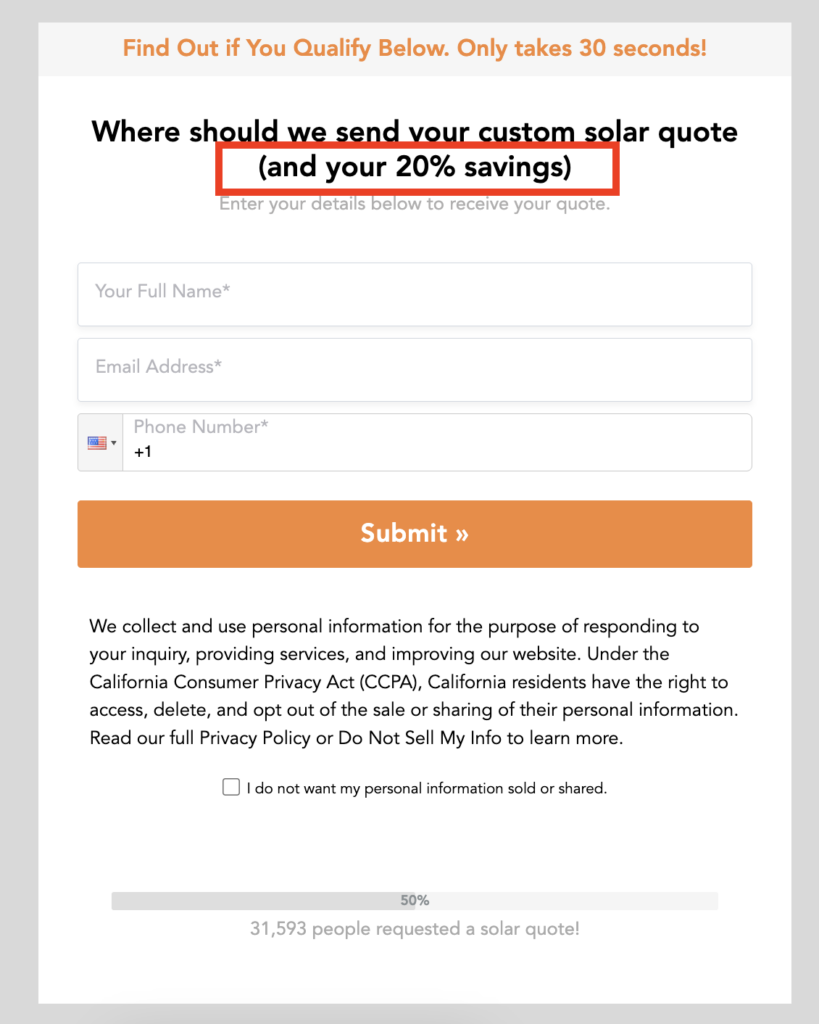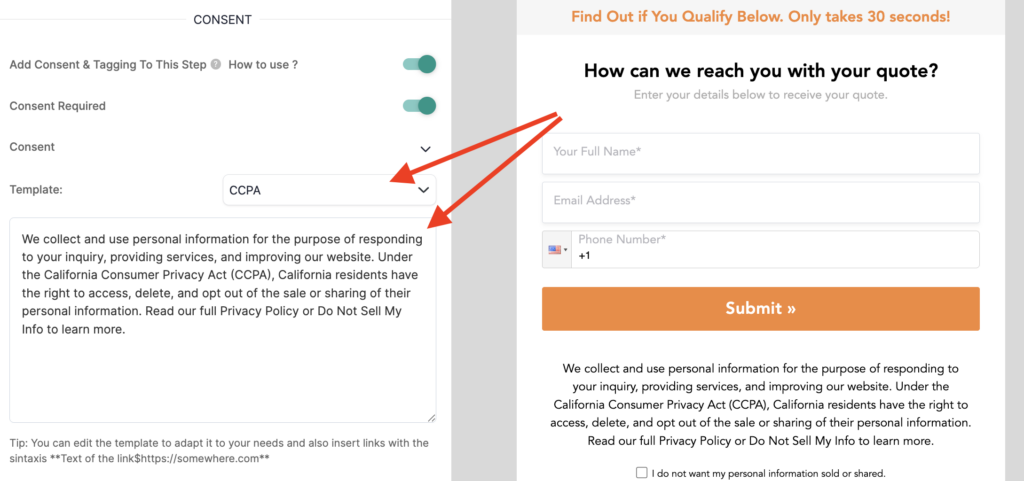Dealing with privacy regulations when capturing leads is a real headache.
And if you’re in the business of generating leads, whether for insurance, solar, financial services, debt relief, or any other industry, you’ve probably felt the pain.
You need your lead forms to convert like crazy, but regulations like CCPA and TCPA loom in the background, adding confusion and a even tad bit of anxiety to the lead capture process.

Personally, I’ve always had questions swirling around in my head like:
Is my compliance text structured the right way?
Am I capturing and storing consent properly?
Plus, how do you follow the rules without your conversion rate dropping off a cliff?
In this post, we’ll tackle this exact dilemma and what we’ve done at LeadCapture.io to solve this.
And I’m even sharing a CCPA template that you can plug right into your lead forms.
Disclaimer: Drawing from insights gathered from marketers who have successfully captured millions of leads, this information is intended for guidance purposes only. It is essential to seek the advice of a legal professional to ensure compliance with relevant laws and regulations.
Ready? Let’s go.
The CCPA Conundrum: Caught Between Compliance and Conversions
Imagine you’ve crafted the perfect lead form. It’s conversion-optimized. Leads are flowing in… awesome!
But then your legal team, lead buyer or client mentions, “What about compliance? We need CCPA!”
Cue the record scratch.
Suddenly you’re scrambling to add a chunky privacy disclaimer or an extra checkbox for consent. And just like that, your once-smooth form now feels like a legal minefield for the user.
Privacy laws are the ultimate party pooper for lead gen pros.
The California Consumer Privacy Act (CCPA) and the Telephone Consumer Protection Act (TCPA) are two biggies that tend to keep marketers, lead sellers and lead buyers up at night.
Here’s why they matter for your lead forms in plain English:
- CCPA: If you collect personal info from consumers (especially in California) and share or sell it (say you pass leads to partners or buyers), you need to be transparent. Consumers have rights – like the right to know what data you collect, delete their data, or tell you “Do Not Sell” their info. Non-compliance can mean fines up to $2,500 per violation (or $7,500 if you “intentionally” messed up)
And yes, “per violation” can mean per lead’s data, it adds up fast. Ouch. - TCPA: If you’re going to call or text those leads (and who isn’t?), you must have their explicit consent. The TCPA basically says you can’t spam people’s phones without permission. If you ignore it, you could get hit with statutory damages of $500 to $1,500 per unwanted call or text. That’s per message… you can do the math on how a big campaign could turn into a legal nightmare. (Hint: it gets expensive quickly.)
Want to explore more about TCPA? Here’s a post that I recently wrote on TCPA compliance.
Now, complying with these laws isn’t just a checkbox (literally and figuratively). It impacts how you design your lead capture process. For example, TCPA might require you to include specific wording and an unchecked opt-in box to capture “prior express written consent” before you autodial or text a prospect.
CCPA might require a disclosure like, “We may share your info with our partners” or a link to a privacy policy and opt-out.

All this is extra friction on your form, which every marketer fears – because more friction usually means fewer conversions. It’s a classic catch-22: play it safe and risk fewer leads, or streamline for leads and risk the legal wrath.
What are the CCPA Requirements When it Comes to Lead Generation?
So, let’s get clear on what’s required for CCPA-compliant lead capture forms that respect consumer rights before focusing on optimizing your conversion rates.
The California Consumer Privacy Act sets forth several mandates that businesses must adhere to when handling personal data of California residents. Here’s how these requirements specifically apply to lead generation:
1. Right to Know
Under the CCPA, consumers have the right to know what personal information is being collected about them. When it comes to inbound lead gen, this means you must clearly disclose:
- The categories of personal information you collect.
- The purposes for which this information will be used.
- The third parties with whom this information will be shared.
Including an upfront disclosure on your lead capture forms or a link to a detailed privacy policy is essential for compliance.
2. Right to Delete
CCPA gives consumers the right to request deletion of their personal information. In the context of lead generation:
- You need to have mechanisms in place to allow consumers to request deletion.
- This could involve providing a simple way for consumers to contact you with deletion requests, and ensuring your systems can adequately erase their data.
3. Right to Opt-Out of Sale
Consumers have the right to opt out of the sale of their personal information. If your lead generation activities involve sharing data with third parties (which could be considered a “sale” under the CCPA):
- You must provide a clear and conspicuous “Do Not Sell My Personal Information” link on your website.
- Ensure that opting out is straightforward for consumers, and that their preferences are respected and actioned quickly.
4. Non-Discrimination
You cannot discriminate against consumers who exercise their CCPA rights. In lead generation practices, this translates to:
- Not offering different levels of service or pricing to consumers who choose to opt-out of data selling unless those differences are directly related to the value provided by the consumer’s data.
5. Notice at or Before Collection
Before collecting personal information, you must notify consumers of what categories of personal information you will collect and the purpose for its collection.
- This notification can be integrated into consent requests on lead capture forms whenever collecting new leads.
Implementation Tips for CCPA Compliance
- Design Your Lead Forms with Transparency and Clarity: Be upfront about data practices through user-friendly consent language and links to comprehensive policies.
- Establish Robust Data Handling Processes: Ensure you have systems for tracking and processing data deletion requests, if necessary.
- Regularly Update and Test Compliance Mechanisms: As privacy laws evolve, make sure your practices do too. Regular audits can help ensure ongoing compliance.
Creating CCPA-compliant lead generation strategies not only keeps you within legal bounds but also builds trust with consumers, fostering a transparent and ethical approach to data collection.
So this leads to the question, what’s an example of a good CCPA compliant template for lead generation?
CCPA Template for Your Lead Capture Forms
Below is a template that you can customize and use to ensure compliance with the California Consumer Privacy Act (CCPA).
We collect and use personal information for the purpose of responding to your inquiry, providing services, and improving our website. Under the California Consumer Privacy Act (CCPA), California residents have the right to access, delete, and opt out of the sale or sharing of their personal information. Read our full Privacy Policy or Do Not Sell My Info to learn more.
Optional Checkbox Copy (if you’re offering a “Do Not Sell” choice on the form itself):
☐ I do not want my personal information sold or shared.
Important Notes:
- Ensure that the “Do Not Sell My Personal Information” link is prominently displayed and functional.
- Update the placeholders [Your Company Name], [email address], and [Privacy Policy link] with your company’s actual information.
- Regularly review and update your privacy policy to reflect any changes in data collection practices.
This template serves as a starting point and should be tailored to fit the specific needs of your business and industry. Always consult with a legal professional to ensure full compliance with CCPA and other applicable data privacy laws.
How to Add CCPA Text Without Impacting Your Conversion Rates
Working smoothly with the CCP) while keeping those conversion rates high can be a bit tricky, but don’t worry! There’s a smart way to do this.
First, try including the CCPA acknowledgments towards the end of a multi-step form, right when you’re gathering contact details.

By this time, your visitor has already spent some time on the form and seems keen on what you’re offering. Introducing the CCPA notice here is less likely to scare them off since their interest indicates they’re inclined to finish the process anyway.
Another trick to keep your prospect hooked is to reiterate the value of your offer before they see the CCPA section. Highlight what they will gain to make it a win-win for them to share their info.

This way, you’re making sure that the benefits are clear and enticing, easing any second thoughts about the legal bits they’re about to encounter.
Finally, you can make life easier with tools like ActiveProspect’s TrustedForm. These handy tools automatically handle the consent part, so you don’t need to clutter your form with extra fields that might overwhelm or push people away. By keeping things simple at the start, your lead capture process stays attractive and easy to complete.
Automating and Managing CCPA Compliance With LeadCapture.io
Adding CCPA-compliant text for your lead forms is a breeze with today’s form builders and lead capture software.
But at LeadCapture.io, we make it even simpler by providing more than just a checkbox for your text — you get ready to go CCPA templates to help improve your compliance workflow.
Our compliance section lets you easily choose and enable a pre-written CCPA template directly in your lead capture form. After selecting the template, adding a checkbox is a snap if it’s required.

Plus, LeadCapture.io enhances your compliance efforts by automatically recording and storing consent with each lead, so you have all the documentation you need right at your fingertips for any audits.
Wrapping Up: Do CCPA Right Without the Headaches
Let’s recap:
- CCPA isn’t optional. The risks (fines, lawsuits, lost trust) are real.
- But compliance doesn’t have to kill your conversions.
- LeadCapture.io makes it simple to build CCPA-compliant lead capture forms that still convert.
With features like consent templates, built-in “Do Not Sell” support, consent storage, and TrustedForm integration, we take the legal load off your plate, so you can focus on what you do best: capturing leads.

